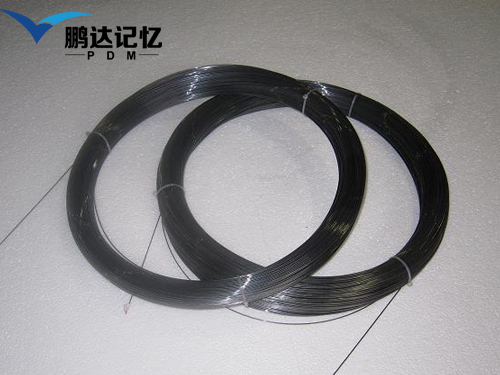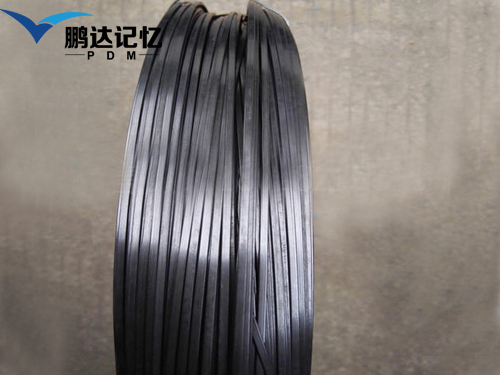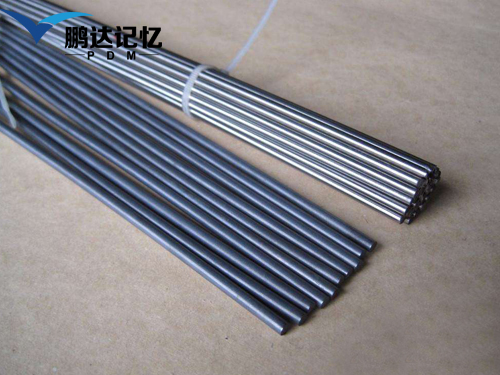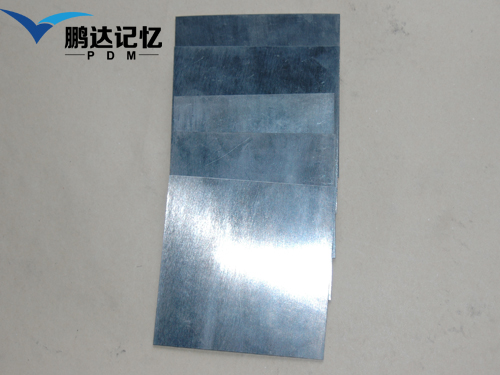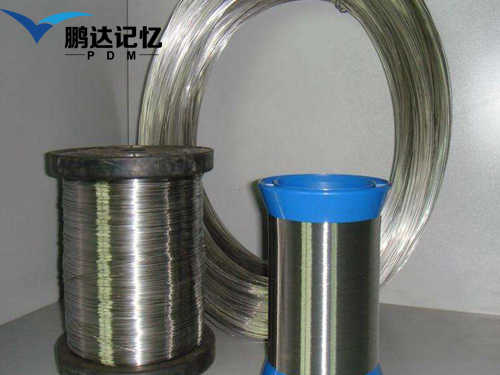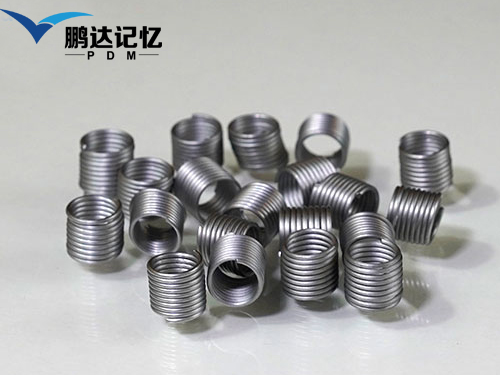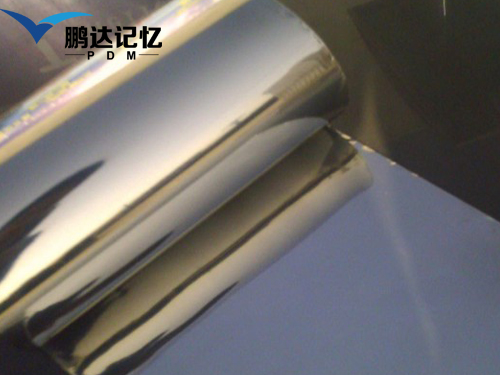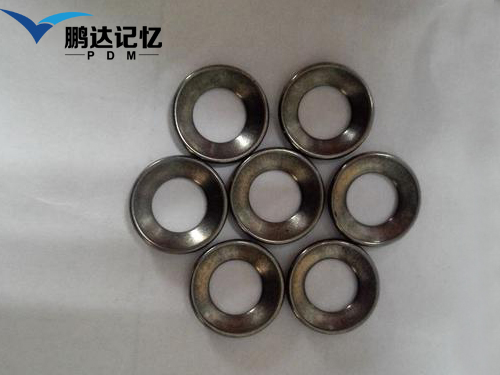Ni Ti alloy is a kind of shape memory alloy. Shape memory alloy is a special alloy which can automatically restore its plastic deformation to its original shape at a certain temperature. Its expansion rate is more than 20%, its fatigue life is 7 times of 1 * 10, its damping property is 10 times higher than that of ordinary spring, its corrosion resistance is better than the best medical stainless steel at present, so it can meet the application requirements of various engineering and medicine, and it is a very excellent functional material.
In addition to its unique shape memory function, memory alloy also has excellent characteristics of wear resistance, corrosion resistance, high damping and super elasticity.
Special properties of NiTi alloy
1. Shape memory is that when the parent phase of a certain shape cools from above Af temperature to below MF temperature to form martensite, the martensite will be deformed below MF temperature, heated to below Af temperature, accompanied by reverse transformation, the material will automatically restore its shape in the parent phase. In fact, shape memory effect is a heat induced phase transformation process of NiTi alloy.
2. Super elastic refers to the phenomenon that the strain produced by the specimen under the action of external force is much larger than the elastic limit strain, and the strain can be recovered automatically when unloading. That is to say, in the parent phase state, due to the effect of external stress, the stress-induced martensitic transformation occurs, so the alloy shows different mechanical behavior from ordinary materials, its elastic limit is far greater than that of ordinary materials, and it no longer complies with Hooke's law. Compared with shape memory, hyperelasticity has no thermal effect. In a word, hyperelasticity means that the stress does not increase with the increase of strain in a certain deformation range, and it can be divided into linear hyperelasticity and nonlinear hyperelasticity. In the stress-strain curve of the former, the relationship between stress and strain is nearly linear. Nonlinear hyperelasticity refers to the results of stress-induced martensitic transformation and its inverse transformation in the process of loading and unloading in a certain temperature range above AF. therefore, nonlinear hyperelasticity is also called transformation pseudoelasticity. The pseudo elasticity of Ni Ti alloy is about 8%. The hyperelasticity of NiTi alloy can be changed with the change of heat treatment conditions. When the bow wire is heated to more than 400oC, the hyperelasticity begins to decrease.
3. Sensitivity of intraoral temperature change: the orthodontic force of stainless steel wire and CoCr alloy orthodontic wire is not affected by intraoral temperature. The orthodontic force of superelastic nitinol alloy dental wires changes with the change of oral temperature. When the deformation is fixed. With the increase of temperature, the correction power increased. On the one hand, it can accelerate the movement of teeth, because the temperature change in the mouth will stimulate the blood flow in the stagnant part of blood flow caused by the appliance, so that the repair cells can be fully nourished and maintain their vitality and normal function in the process of tooth movement. On the other hand, orthodontists can not accurately control or measure the orthodontic force in the oral environment.
4. Corrosion resistance: some researches show that the corrosion resistance of NiTi wire is similar to that of stainless steel wire
5. Antitoxicity: the special chemical composition of nitinol shape memory alloy, that is, it is an atomic alloy such as nitinol, containing about 50% nickel, which is known to have carcinogenic and cancer promoting effects. In general, the oxidation of titanium on the surface acts as a barrier, which makes Ni Ti alloy have good biocompatibility. TixOy and tixnioy of the surface layer can inhibit the release of Ni.
6. Soft orthodontic force: at present, the commercial orthodontic wires include austenitic stainless steel wire, cobalt chromium nickel alloy wire, nickel chromium alloy wire, Australian alloy wire, gold alloy wire and titanium alloy wire. The load displacement curves of these orthodontic wires under tensile test and three-point bending test conditions. The unloading curve platform of nitinol alloy is the lowest and the flattest, which shows that it can provide the most lasting and soft corrective force.
7. Good shock absorption characteristics: the greater the vibration caused by chewing and night molars to the arch wire, the greater the damage to the root and periodontal tissue. The results of different arch wire attenuation experiments show that the vibration amplitude of stainless steel wire is larger than that of super elastic NiTi wire, and the initial vibration amplitude of super elastic NiTi wire is only half of that of stainless steel wire. The good vibration and shock absorption characteristics of arch wire are very important for the health of teeth, while the traditional arch wire, such as stainless steel wire, tends to increase the root absorption.
Clinical application of nitinol alloy wire:
1. Because of the super elasticity, shape memory and low stress-strain curve of nitinol alloy arch wire, nitinol alloy arch wire is used as the initial arch wire in the orthodontic system in clinical practice, so the discomfort of patients will be greatly reduced. Because there are several different straight wire orthodontic techniques, mbt technology recommends the use of 0.016 inch hot activated nitinol alloy wire (hant wire), demon self-locking bracket technology recommends the use of copper containing hot activated nitinol alloy wire (phase change temperature is about 40 degrees left and right), o-pak technology recommends the use of 0.016 inch super elastic nitinol alloy wire for early alignment and leveling.
2. Nitinol spring: nitinol push spring and pull spring is a kind of spring used in orthodontics. It has the characteristics of nitinol hyperelasticity. It is suitable for orthodontics to open up the space between teeth and pull teeth in different directions. The Ni Ti coil spring can produce a force of about 50g when it is extended for 1mm. Ni Ti coil spring has a high elastic property, which can produce soft and stable sustained force under tension. The attenuation of force is very small, which can produce ideal orthodontic force for clinical moving teeth. Meet the physiological requirements.
3. L-H bow wire is researched and developed by Dr. soma of Japan and produced by Tommy company. "LH" is named from "lowhysteresis", that is to say, when the arch wire is tied to the bracket, the difference between the stress generated when the arch wire is activated and the stress generated when the arch wire is slowly restored to the original state when the tooth is moved is very small. That is, the lag is very small. Soma et al. Compared the stress-strain curves of LH bow wire with other nitinol alloy wires, the lag range of L-H bow wire is the smallest, which makes the bow wire have the advantages of low load and sustained light force. At the same time, the initial inclination of the curve is low, which shows that the rigidity of the bow wire is low, and the lag curve of other nitinol alloy bowwire shows that its rigidity is large, obviously L-H bow wire has obvious mechanical advantages. Because the proportion of Ti in Ni Ti composition of LH wire is higher than that of Ni Ti bow wire, it is called Ti Ni wire, and its shock absorption effect is proved to be strong by experiments. Another characteristic of LH nitinol wire is that it can be bent and shaped by heat treatment instrument. Therefore, the LH nitinol wire can also be leveled, opened and closed from the alignment, opening and closing the gap, and the final completion stage. Each upper and lower arch wire can complete the treatment, as long as the arch wire is taken out of the required shape at each stage and bent, and then it can be shaped by heat treatment instrument to strengthen the hardness Yes. At present, L-H arch wire is used in clinical expansion treatment to correct open jaw, partial jaw and reverse jaw, because of its continuous stability and softness, the effect is better. At the same time, J-hook is often used to improve the weakness of bow wire. Although MEAW technique is also effective in correcting the above malocclusion, many doctors are often deterred by the complicated bow wire bending. Therefore, some doctors have changed to use rocking chair type nitinol wire with vertical traction of front teeth, although this has similar effect, they always feel that when compared with MEAW, the movement of each independent tooth is not as good as MEAW technology, because rocking chair type nitinol wire is a continuous arch wire, and there is no way to bend. Therefore, the angle of bracket bonding and the curvature of the rocking chair determine the angle of each tooth. Unlike MEAW, the angle of each tooth has more space for individual adjustment. Using LH nitinol to bend the rocking chair, and then using bow wire former to bend backward or forward in the mouth, the effect is quite ideal.

 current location:
current location:
